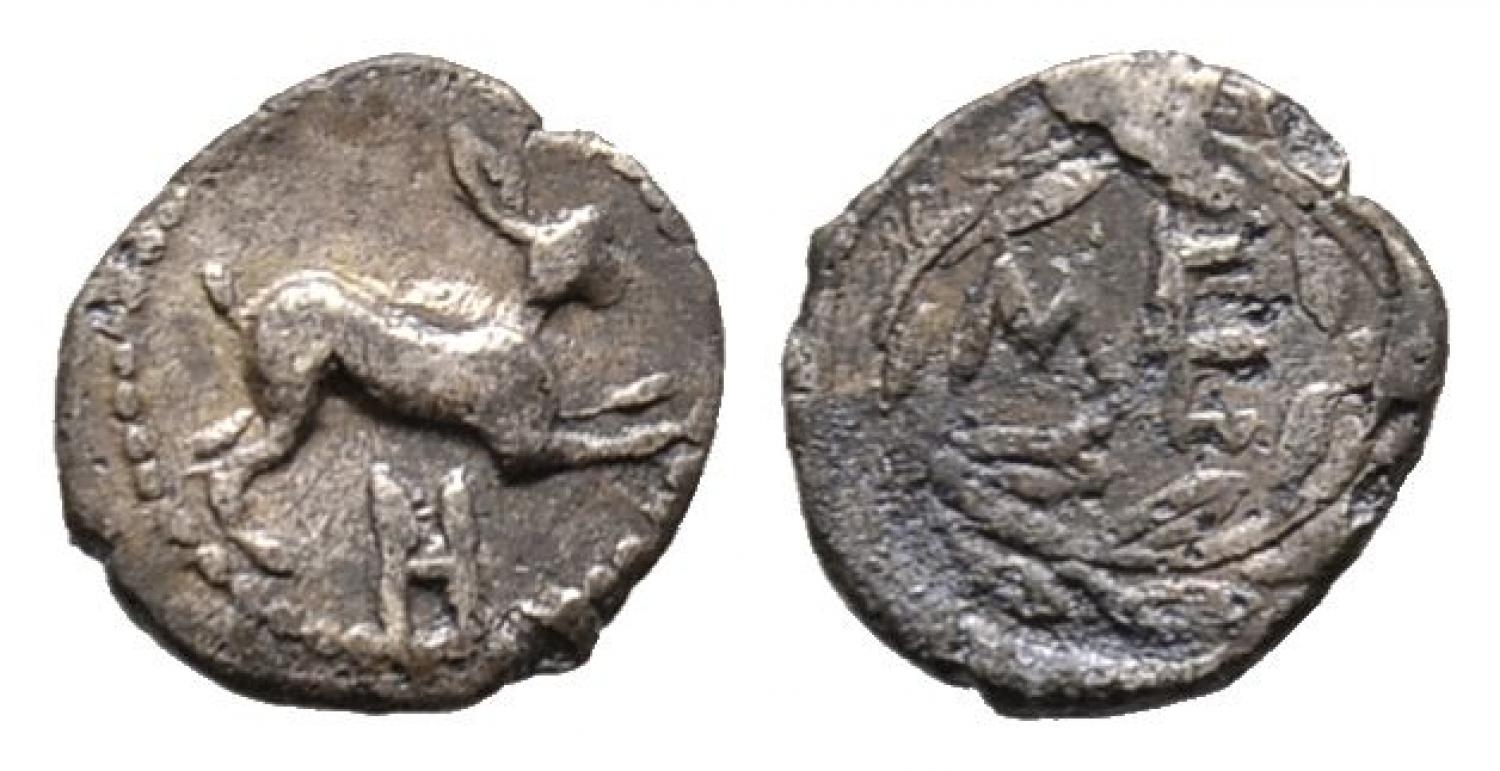AC 67a - Messana, silver, hemilitrae (433-429 BCE)
From SILVER
433 BCE - 429 BCE Silver 53 kg
Description
| ObverseInscription or printing placed on the obverse.: | Hare r. |
| ReverseInscription or printing placed on the reverse.: | ME (Greek).Legend within wreath |
Mint and issuing power
| MintIdentifies the place of manufacture or issue of a numismatic object.: | Messana | Ancient regionAncient region.: | Sicily | Modern countryModern country: Italy | AuthorityIdentifies the issuing power. The authority can be "pretended" when the name or the portrait of X is on the coin but he/she was not the issuing power. It can also be "uncertain" when there is no mention of X on the coin but he/she was the issuing power according to the historical sources: |
Chronology
| FromIdentifies the initial date in a range assigned in a numismatic context. | 433 BCE | toIdentifies the final date in a range assigned in a numismatic context.. | 429 BCE | PeriodTime period of the numismatic object.: Classical 480-323 BC |
Physical description
| MetalThe physical material (usually metal) from which an object is made.: | Silver |
Median weightMedian of the weights of numismatic objects (in grams). in grams | 0.35 | DenominationTerm indicating the value of a numismatic object. Examples: tetradrachm, chalkous, denarius.: | hemilitra |
StandardStandard.: |
Image

AC 67a - Zancle, silver, hemilitra, 460-426 BC.jpg [1]
References
| Die study referencePublication of the study: | Caccamo Caltabiano 19931Caccamo Caltabiano 1993, n° 346-7, 461 and 477 | ||
| Coin series referenceReference to coin series study: | RQEMAC2RQEMAC, n° 67a | ||
Obverse dies distribution
| FrequencyFrequency of specimen in distribution. ᵖ | Number of obversesNumber of obverse dies. ᵖ (o) | % (o) | Number of coinsNumber of coins. (n) | % (n) | Die nameName(s) of the die(s). |
| 1 | 1 | 25 | 1 | 14.29 | 346 |
| 2 | 3 | 75 | 6 | 85.71 | 347, 1 |
| Total | 4 of 4 | 100 | 7 of 7 | 100 |
Reverse dies distribution
no distribution is available
Quantification
| Number of obversesNumber of obverse dies. ᵖ (o) | 4 | Number of singletons (o1)The number of singleton coins. ᵖ | 1 |
| Number of reverse diesNumber of reverse dies. (r) | 4 | Number of coinsNumber of coins. (n) | 7 |
| Coins per obverse dieNumber of coins per obverse die. (n/o) | 1.75 | Coins per reverse dieNumber of coins per reverse die. (n/r) | 1.75 |
| Reverse per obverse ratioRatio of obverse dies divided by reverse dies. (r/o) | 1 | Percentage of singletons (o1)number of coins (n) divided by the number of singletons (o1) ᵖ | 25 % |
| Original number of dies (O) (Carter 1983 formula)The estimation of the number of coins according to Carter 1983 ᵖ | 7.55 | Coins struck if 20,000 as average productivity per dieCoins made if the average productivity for obverses (according to Carter) is 20,000. ᵖ | 151,000 |
| Original number of dies (O) (Esty 2011 formula)The estimation of the number of coins according to the singleton formula in Esty 2011 ᵖ (O) | 9.33 | Survival rate if 20,000 as average productivity per dieSurvival rate if average productivity is 20,000. ᵖ | 0.00005 |
| Coverage (o = % of O) (Esty 1984 formula)Esty 1984 - coverage (% of O) ᵖ (o = % of O) | 85.71% | Die productivity if survival rate 1/2,000Average productivity if survival rate is 1/2,000. ᵖ | 1,854.3 |
| Weight of silver (in kg) if 20,000 coins per die (O = Carter formula)Carter 1983 * Median weight * 20000 (*10 if gold or electrum) ᵖ | 53 kg <br /> 53 kg | Die productivity if survival rate 1/5,000Average productivity if survival rate is 1/5,000. ᵖ | 4,635.76 |
Remarks